Abstract
Cloned coding sequences for rat and human ornithine transcarbamylase (OTC) were obtained by screening a rat and a human cDNA library respectively with a synthetic oligonucleotide corresponding to 27 bases of the rat sequence. These clones, 1100 bp long for the rat clone and 1300 bp for the human, contain approximately 80% of the human OTC coding sequence. The OTC mRNA length determined by Northern blot analysis is 1700bp. The human OTC sequence was shown to be localised Xp11.4-Xp21 using somatic cell hybrids. There is a frequent RFLP revealed with the restriction enzyme MspI. OTC is located more closely to the Duchenne muscular dystrophy mutation than previously reported markers such as RC8 and L1.28, and therefore should prove useful in carrier detection and haplotype analysis of families carrying the mutation causing the disease.
Full text
PDF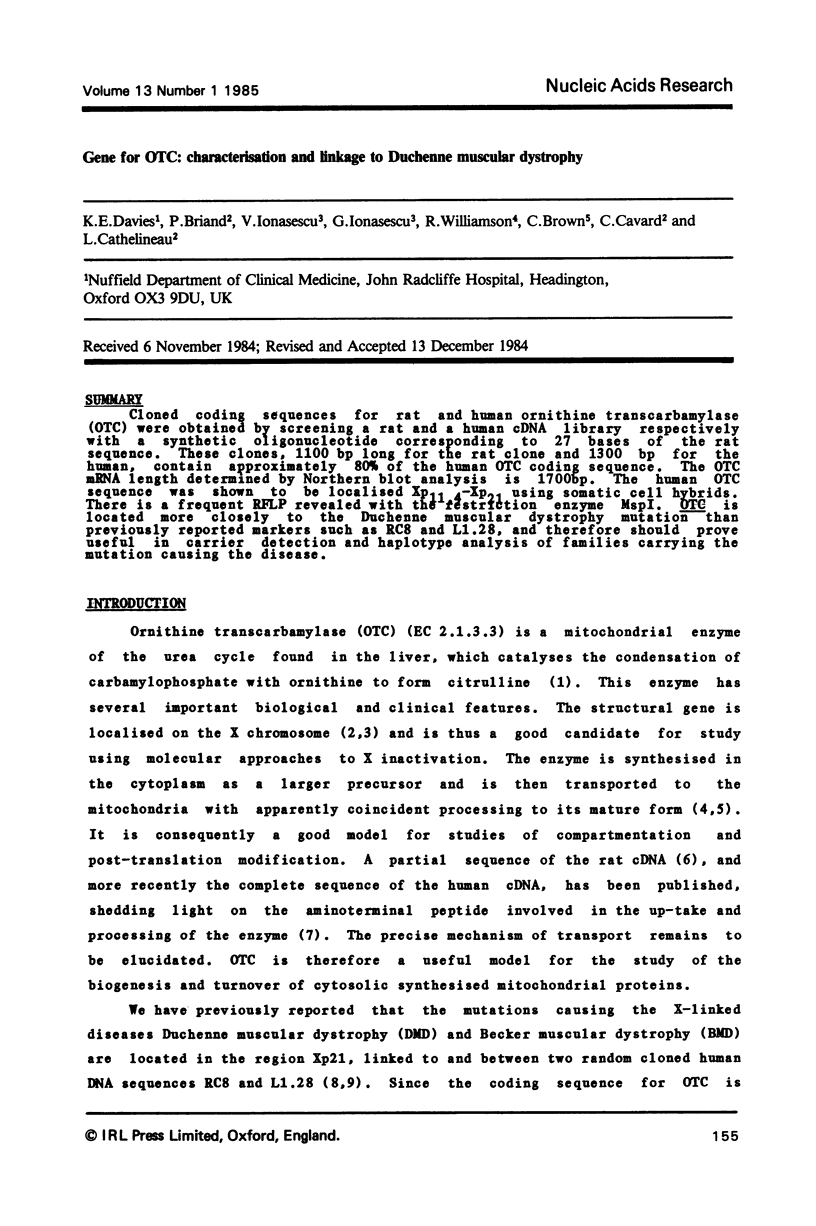
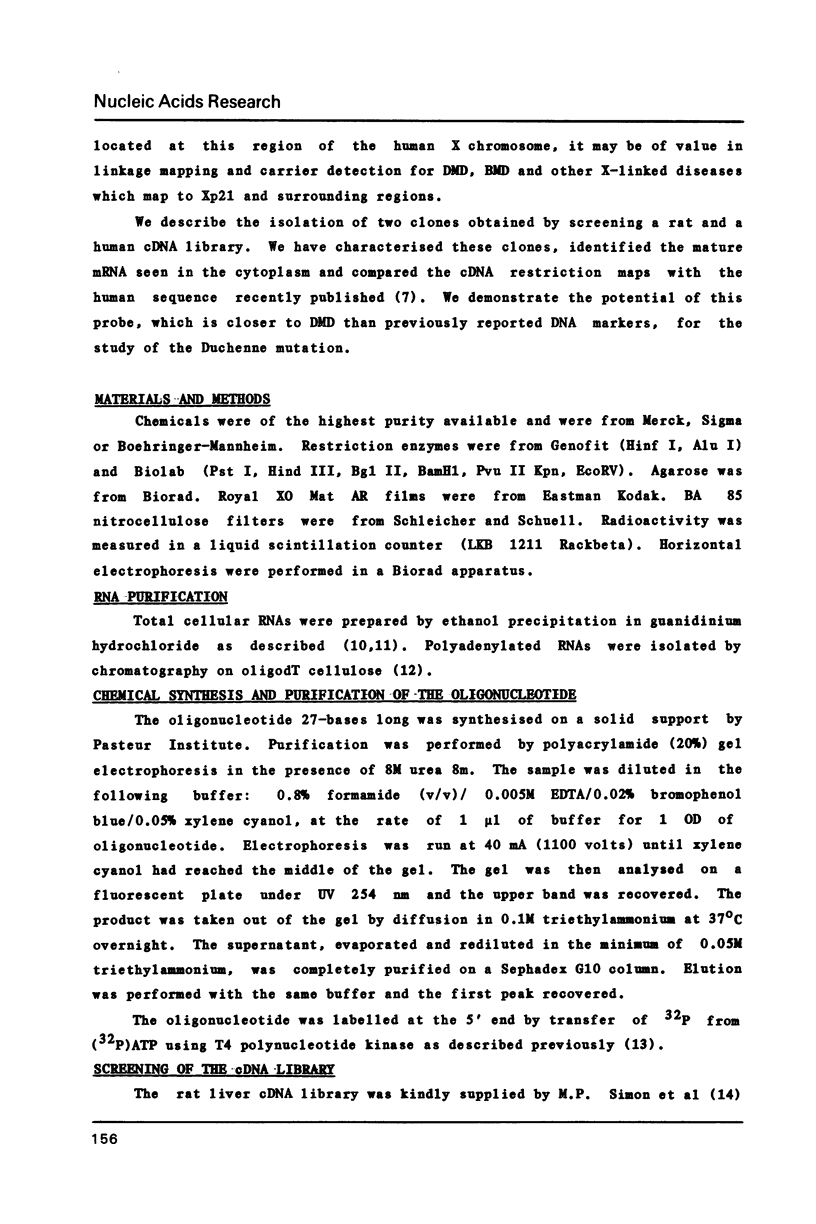
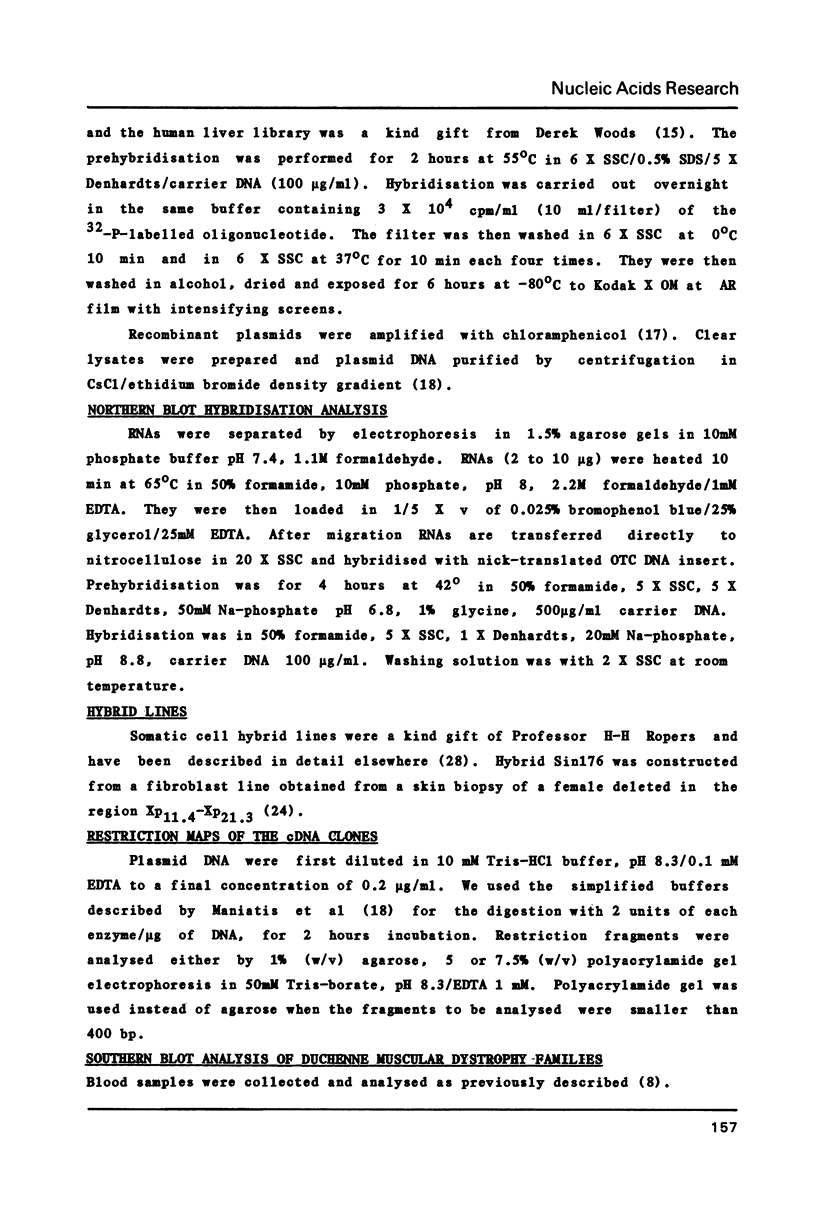
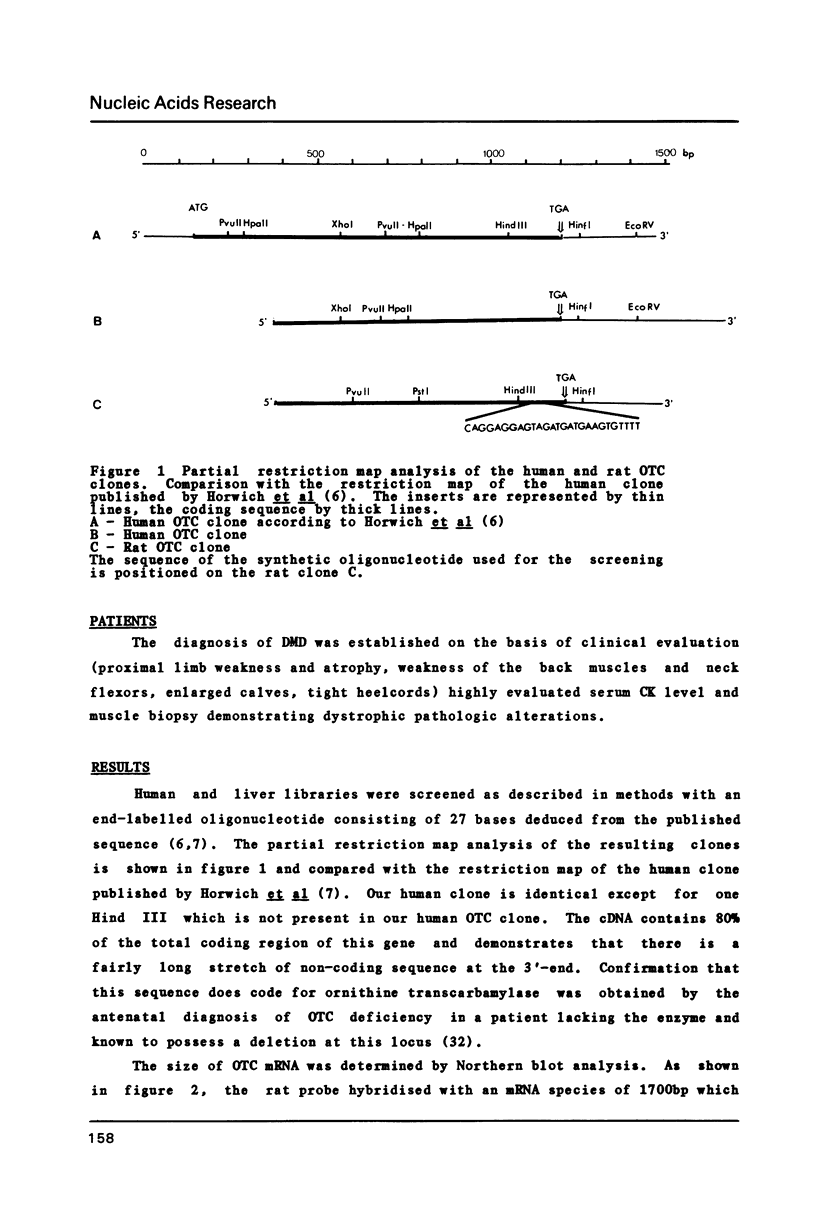
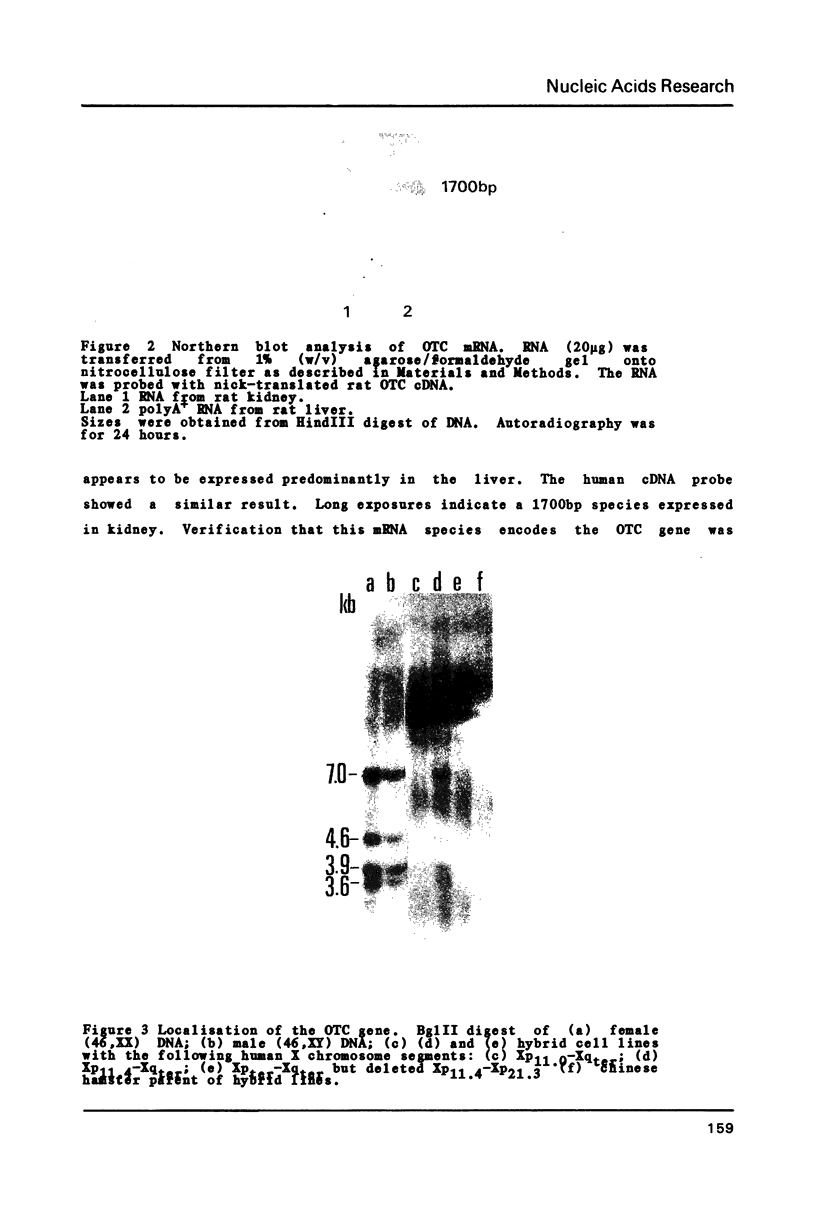

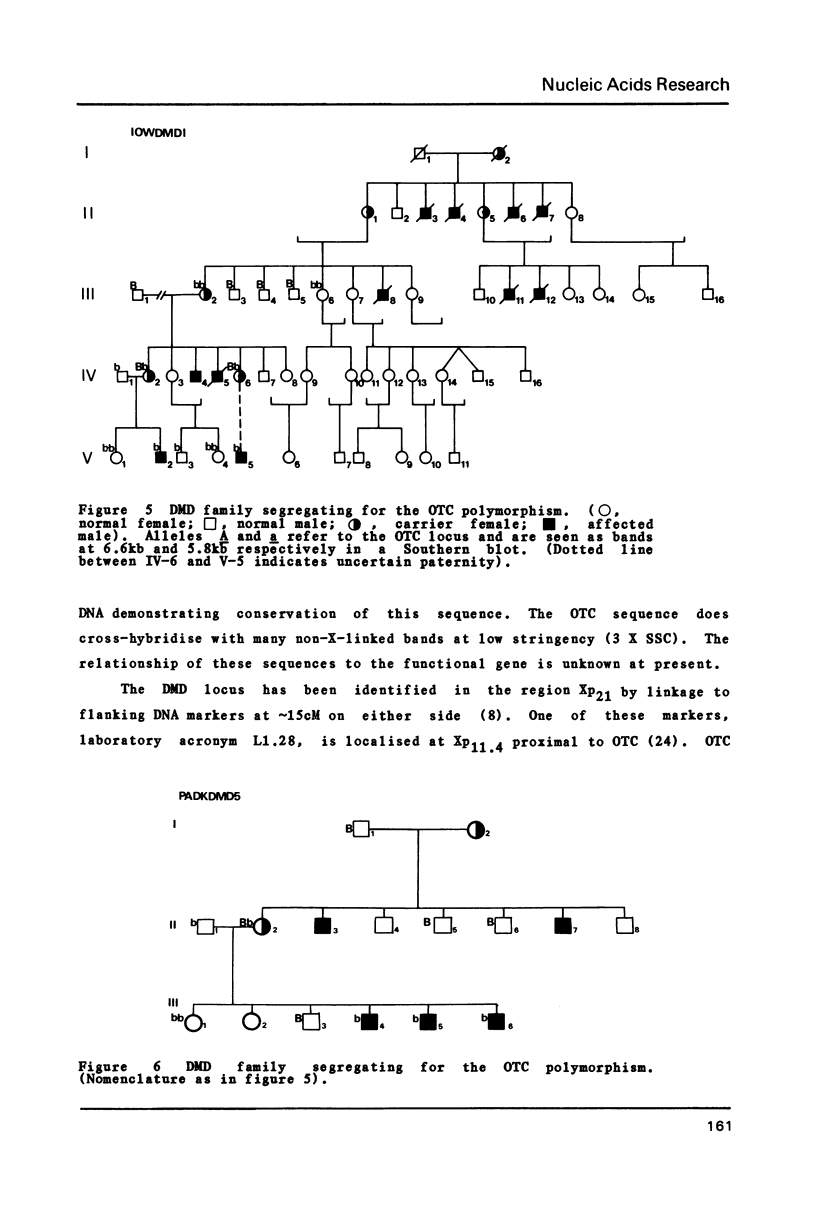
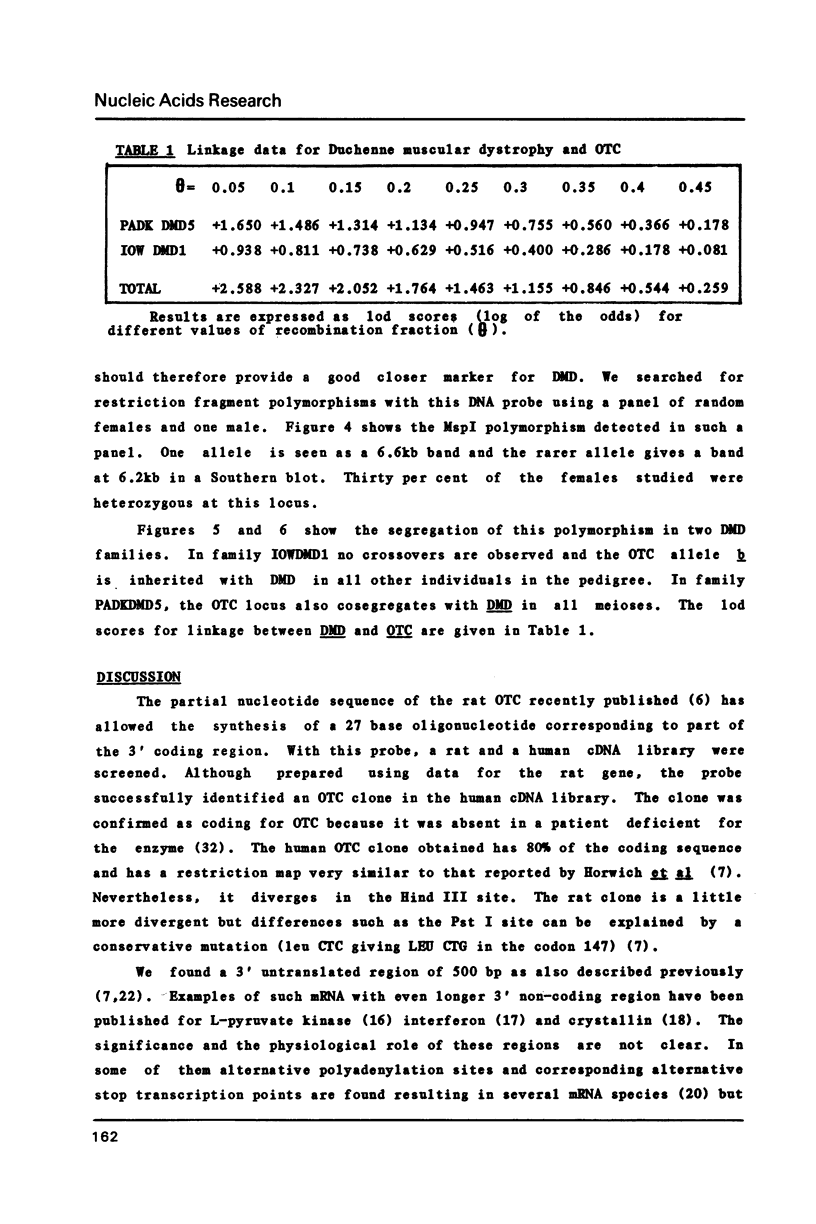
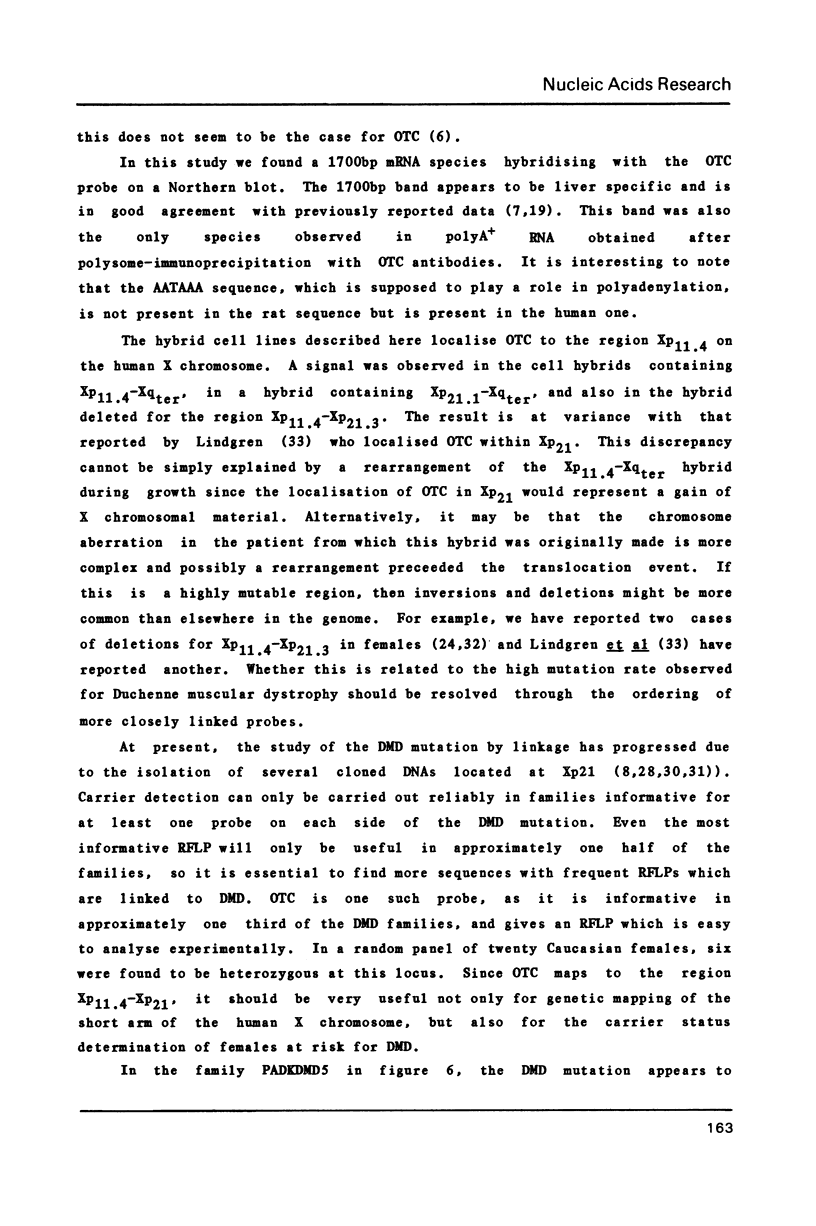
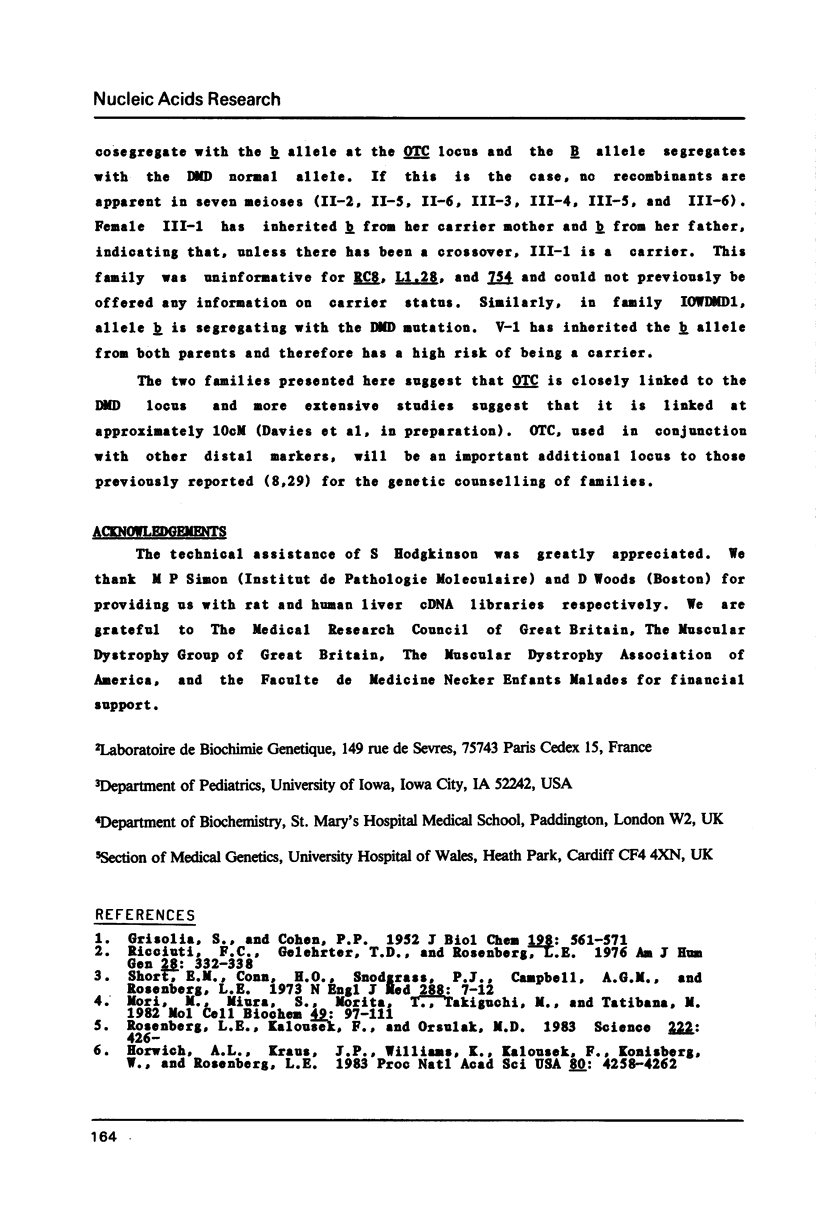
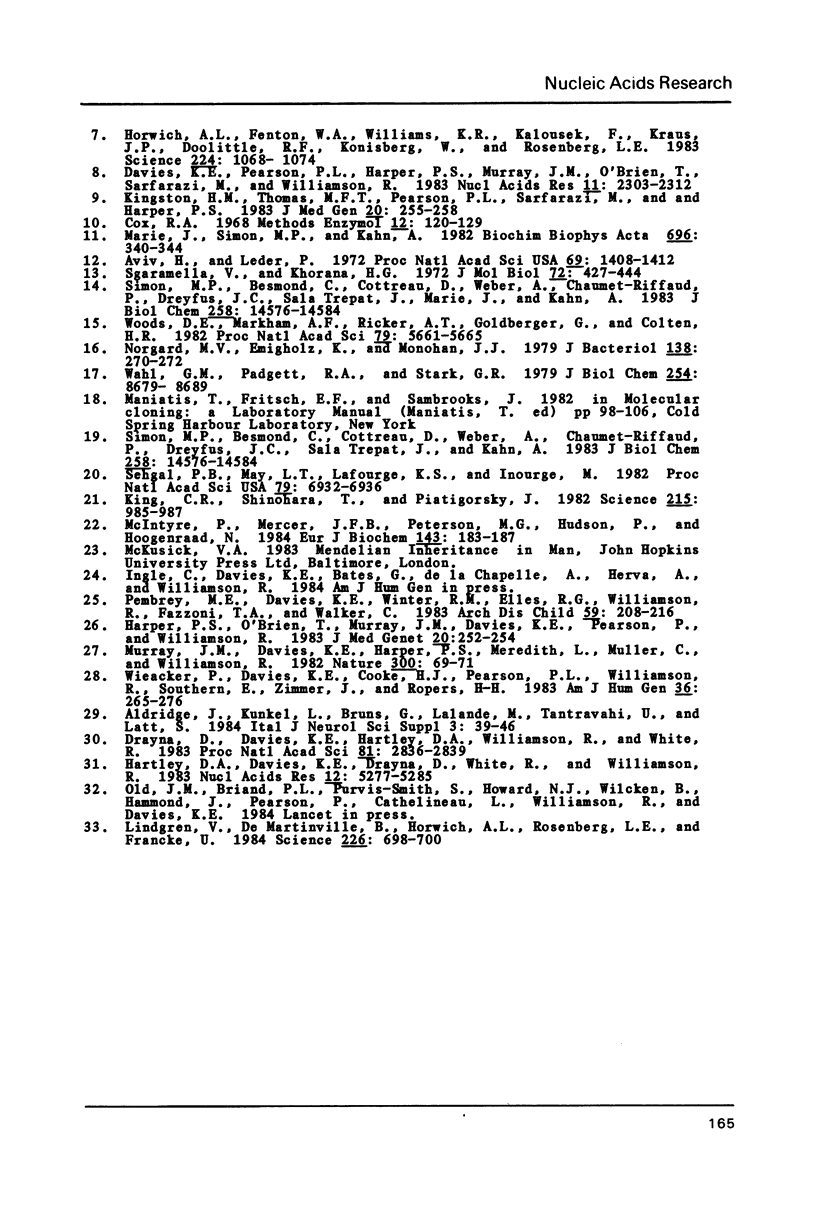
Images in this article
Selected References
These references are in PubMed. This may not be the complete list of references from this article.
- Aviv H., Leder P. Purification of biologically active globin messenger RNA by chromatography on oligothymidylic acid-cellulose. Proc Natl Acad Sci U S A. 1972 Jun;69(6):1408–1412. doi: 10.1073/pnas.69.6.1408. [DOI] [PMC free article] [PubMed] [Google Scholar]
- Drayna D., Davies K., Hartley D., Mandel J. L., Camerino G., Williamson R., White R. Genetic mapping of the human X chromosome by using restriction fragment length polymorphisms. Proc Natl Acad Sci U S A. 1984 May;81(9):2836–2839. doi: 10.1073/pnas.81.9.2836. [DOI] [PMC free article] [PubMed] [Google Scholar]
- GRISOLIA S., COHEN P. P. The catalytic rôle of carbamyl glutamate in citrulline biosynthesis. J Biol Chem. 1952 Oct;198(2):561–571. [PubMed] [Google Scholar]
- Hartley D. A., Davies K. E., Drayna D., White R. L., Williamson R. A cytological map of the human X chromosome--evidence for non-random recombination. Nucleic Acids Res. 1984 Jul 11;12(13):5277–5285. doi: 10.1093/nar/12.13.5277. [DOI] [PMC free article] [PubMed] [Google Scholar]
- Horwich A. L., Fenton W. A., Williams K. R., Kalousek F., Kraus J. P., Doolittle R. F., Konigsberg W., Rosenberg L. E. Structure and expression of a complementary DNA for the nuclear coded precursor of human mitochondrial ornithine transcarbamylase. Science. 1984 Jun 8;224(4653):1068–1074. doi: 10.1126/science.6372096. [DOI] [PubMed] [Google Scholar]
- Horwich A. L., Kraus J. P., Williams K., Kalousek F., Konigsberg W., Rosenberg L. E. Molecular cloning of the cDNA coding for rat ornithine transcarbamoylase. Proc Natl Acad Sci U S A. 1983 Jul;80(14):4258–4262. doi: 10.1073/pnas.80.14.4258. [DOI] [PMC free article] [PubMed] [Google Scholar]
- King C. R., Shinohara T., Piatigorsky J. alpha A-crystallin messenger RNA of the mouse lens: more noncoding than coding sequences. Science. 1982 Feb 19;215(4535):985–987. doi: 10.1126/science.7156978. [DOI] [PubMed] [Google Scholar]
- Kingston H. M., Thomas N. S., Pearson P. L., Sarfarazi M., Harper P. S. Genetic linkage between Becker muscular dystrophy and a polymorphic DNA sequence on the short arm of the X chromosome. J Med Genet. 1983 Aug;20(4):255–258. doi: 10.1136/jmg.20.4.255. [DOI] [PMC free article] [PubMed] [Google Scholar]
- Lindgren V., de Martinville B., Horwich A. L., Rosenberg L. E., Francke U. Human ornithine transcarbamylase locus mapped to band Xp21.1 near the Duchenne muscular dystrophy locus. Science. 1984 Nov 9;226(4675):698–700. doi: 10.1126/science.6494904. [DOI] [PubMed] [Google Scholar]
- Marie J., Simon M. P., Kahn A. Cotranslation of L and L' pyruvate kinase messenger RNAs from human fetal liver. Biochim Biophys Acta. 1982 Mar 29;696(3):340–344. doi: 10.1016/0167-4781(82)90066-5. [DOI] [PubMed] [Google Scholar]
- McIntyre P., Mercer J. F., Peterson M. G., Hudson P., Hoogenraad N. Selection of a cDNA clone which contains the complete coding sequence for the mature form of ornithine transcarbamylase from rat liver: expression of the cloned protein in Escherichia coli. Molecular cloning of rat ornithine transcarbamylase. Eur J Biochem. 1984 Aug 15;143(1):183–187. doi: 10.1111/j.1432-1033.1984.tb08357.x. [DOI] [PubMed] [Google Scholar]
- Mori M., Miura S., Morita T., Takiguchi M., Tatibana M. Ornithine transcarbamylase in liver mitochondria. Mol Cell Biochem. 1982 Nov 26;49(2):97–111. doi: 10.1007/BF00242488. [DOI] [PubMed] [Google Scholar]
- Norgard M. V., Emigholz K., Monahan J. J. Increased amplification of pBR322 plasmid deoxyribonucleic acid in Escherichia coli K-12 strains RR1 and chi1776 grown in the presence of high concentrations of nucleoside. J Bacteriol. 1979 Apr;138(1):270–272. doi: 10.1128/jb.138.1.270-272.1979. [DOI] [PMC free article] [PubMed] [Google Scholar]
- Pembrey M. E., Davies K. E., Winter R. M., Elles R. G., Williamson R., Fazzone T. A., Walker C. Clinical use of DNA markers linked to the gene for Duchenne muscular dystrophy. Arch Dis Child. 1984 Mar;59(3):208–216. doi: 10.1136/adc.59.3.208. [DOI] [PMC free article] [PubMed] [Google Scholar]
- Ricciuti F. C., Gelehrter T. D., Rosenberg L. E. X-chromosome inactivation in human liver: confirmation of X-linkage of ornithine transcarbamylase. Am J Hum Genet. 1976 Jul;28(4):332–338. [PMC free article] [PubMed] [Google Scholar]
- Short E. M., Conn H. O., Snodgrass P. J., Campbell A. G., Rosenberg L. E. Evidence for x-linked dominant inheritance of ornithine transcarbamylase deficiency. N Engl J Med. 1973 Jan 4;288(1):7–12. doi: 10.1056/NEJM197301042880102. [DOI] [PubMed] [Google Scholar]
- Simon M. P., Besmond C., Cottreau D., Weber A., Chaumet-Riffaud P., Dreyfus J. C., Trépat J. S., Marie J., Kahn A. Molecular cloning of cDNA for rat L-type pyruvate kinase and aldolase B. J Biol Chem. 1983 Dec 10;258(23):14576–14584. [PubMed] [Google Scholar]
- Simon M. P., Besmond C., Cottreau D., Weber A., Chaumet-Riffaud P., Dreyfus J. C., Trépat J. S., Marie J., Kahn A. Molecular cloning of cDNA for rat L-type pyruvate kinase and aldolase B. J Biol Chem. 1983 Dec 10;258(23):14576–14584. [PubMed] [Google Scholar]
- Wahl G. M., Padgett R. A., Stark G. R. Gene amplification causes overproduction of the first three enzymes of UMP synthesis in N-(phosphonacetyl)-L-aspartate-resistant hamster cells. J Biol Chem. 1979 Sep 10;254(17):8679–8689. [PubMed] [Google Scholar]
- Wieacker P., Davies K. E., Cooke H. J., Pearson P. L., Williamson R., Bhattacharya S., Zimmer J., Ropers H. H. Toward a complete linkage map of the human X chromosome: regional assignment of 16 cloned single-copy DNA sequences employing a panel of somatic cell hybrids. Am J Hum Genet. 1984 Mar;36(2):265–276. [PMC free article] [PubMed] [Google Scholar]
- Woods D. E., Markham A. F., Ricker A. T., Goldberger G., Colten H. R. Isolation of cDNA clones for the human complement protein factor B, a class III major histocompatibility complex gene product. Proc Natl Acad Sci U S A. 1982 Sep;79(18):5661–5665. doi: 10.1073/pnas.79.18.5661. [DOI] [PMC free article] [PubMed] [Google Scholar]





